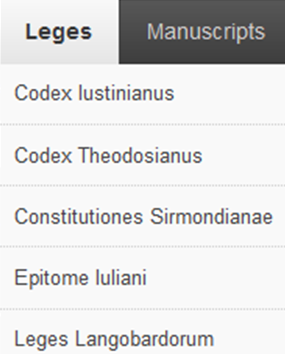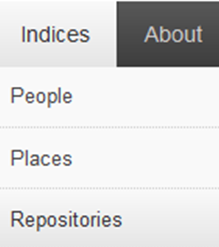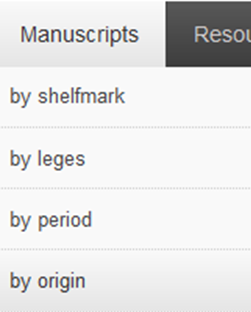FAQs
What does the Bl website offer?
The Bl focuses on the legal knowledge that was prevalent in the Francia. All “leges” (secular law texts) that were copied during the Carolingian period are incorporated.
The website is available in German and English. To change between the two versions, use the flags on the right sight of the menu.
An introductory text to each “lex” including reading recommendations, as well as short descriptions of all codices containing these texts are provided. Information on repository, origin and history of the manuscript, contents as well as bibliographical references etc. are given. At the moment there are 282 short descriptions available.

The aim of the Bl is to take up the current state of research and also the research history as complete as possible. Therefore a lot of effort was put into gathering this information. All prior studies concerning single manuscripts as well as several editions of the law texts were surveyed. For each manuscript, age determinations and assumptions about its origin carried out by the different describers are recorded. Thus the features of the various print editions are transposed into the electronic version.
With kind permission of the “Monumenta Germaniae Historica” (MGH) it was possible to also integrate the complete text of the “Bibliotheca capitularium regum Francorum manuscripta. Überlieferung und Traditionszusammenhang der fränkischen Herrschererlasse” by Hubert Mordek (Munich 1995), which is the most comprehensive work on codices from the respective period. It is not only downloadable in its totality of more than 1000 pages as a PDF, but also as compilations of pages regarding single manuscripts that have been described by him.
Via the resources tab you can find further information such as stemmata, studies and a comprehensive bibliography.

Indices and people, places and institutions facilitate orientation.

A blog informs about current developments and events such as workshops on related topics. See the blogroll on the home page.
Which resources does the Bl use?
The Bl sees itself primarily as a manuscript database, but also as a portal providing access to further information.
Primarily we link to external resources like the large digitization projects as Europeana Regia or to individual libraries. If a digital image is available, you can find a note below the idication of the actual provenance.
Furthermore, we also link to websites on which the relevant literature or editions are made available (eg. dMGH). The premise here is that these are openly accessible. Therefore articles in standard works such as the “Lexikon des Mittelalters” (Encyclopedia of the Middle Ages) are of course mentioned, but no direct references are made, because the content is only available for registered users.
Regarding information on people and places we link to the Wikipedia. You can find the links in the respective indices together with the relevant ids of the authority files such as the VIAF.
Surely, the aforementioned subject-specific resources are of higher value, but Wikipedia is used very broadly and has the additional advantage of offering articles in different languages. The quality of information certainly differs, but according to experience, Wikipedia provides a pretty good starting point for researching a topic. – Of course it should never represent the end of such a survey!
It must therefore be in the interest of the research community to actively participate in improving the quality of Wikipedia .
How to use this site
The easiest way to get to the information needed is via the main navigation menu. If there are underlying tabs available, a flyout menu will appear on mouse-over.

Further tabs such as the one for downloads can be found in the footer navigation.
A short information about what “leges” actually are and which texts are subsumed under this term can be found under leges.
The manuscript descriptions can be reached in various ways:

-
- The main menu tab “Manuscripts” offers a table of the manuscripts included in the Bibliotheca legum. The information given here is restricted to shelfmark, leges contained and origin.
- Under “by shelfmark” the codices are listed by their shelfmark in alphabetical order.
- “By origin” shows the codices according to their places of origin. If there are different assumptions about the origin, the respective codices are listed more than once.
- “by period” according to their time of origin. If there are different assumptions about their period of origin, the respective codices are listed more than once.
- A list ordered by the leges contained can be found under “by leges“. The manuscripts are listed for each text they contain.
- On the start page there is also the option of selecting manuscripts according to specific criteria or combinations of criteria.
-
- Also a full text search is available.
- Also a full text search is available.
To facilitate orientation we use breadcrumbs.
Which law texts are included?
Medieval law is a research field of interest to historians, medievalists as well as legal scholars. Especially regarding the past it is often quite difficult to determine what applicable law actually was. The Bl aspires to do so with a focus on the legal knowledge that was prevalent in the Francia. All leges (secular law texts; often referred to as “leges barbarorum”) that were copied during the Carolingian period are incorporated.

How to find information on the law texts
The survey texts provide very brief introductions to the individual leges. Moreover, in this context, the authoritative editions, relevant studies (since 2000) as well as further materials or external resources are indicated.
Additionally all manuscripts are listed which contain the respective lex.
How to find manuscript descriptions
Descriptions of the manuscripts can be reached in various ways: In a table the basic information such as the origin and the leges contained are shown for each codex. From the main menu, they can also be accessed by shelfmark (in alphabetical order), by the law texts (leges) contained, by time and place of origin.
Additionally, a full text search is available via the search box in the upper right corner.
On the start page there is also the option of selecting manuscripts according to specific criteria or combinations of criteria.
On some sites, it may also be helpful to use the CTRL + F search function.
How to find digital images of the manuscripts
The Bl heavily relies on existing resources. With regard to the needs of academic research, it gathers all digital images available of the respective manuscript testimonies (e.g. from “Europeana”, “Gallica”) as well as catalogue information (e.g. “Manuscripta Mediaevalia”).
If a digital image is available, the note “digitized version available at …” can be found in the description of the manuscript below the indication of provenance.
By clicking on the mentioned institution a new window will open in which the digitized manuscript can be seen.
Note: The new window can not be opened if JavaScript or the appearance of pop-ups is disabled!
How to quote the Bl
We recommend to quote the Bibliotheca legum website as follows:
Bibliotheca legum regni Francorum manuscripta, Karl Ubl (Ed.) assisted by Dominik Trump and Daniela Schulz, Cologne 2012. URL: http://www.leges.uni-koeln.de/en
For specific pages please use the complete URL.
Technologies of the Bl
The text encoding is carried out according to the TEI P5 standard.
People and places are tagged and enhanced according to authority files such as VIAF or TGN to enable identification.
WordPress is used as a CMS for data management and to provide basic functions. While this platform is very common in the World Wide Web, it is not widely adopted for Digital Humanities’ projects working with XML data. The XSLT processing of the XML files within WordPress as well as certain other features (multilingualism, viewers etc.) are realized by plugins. The Bl is published under Creative Commons licence. XML source files are provided for all manuscripts and are freely available for download.

